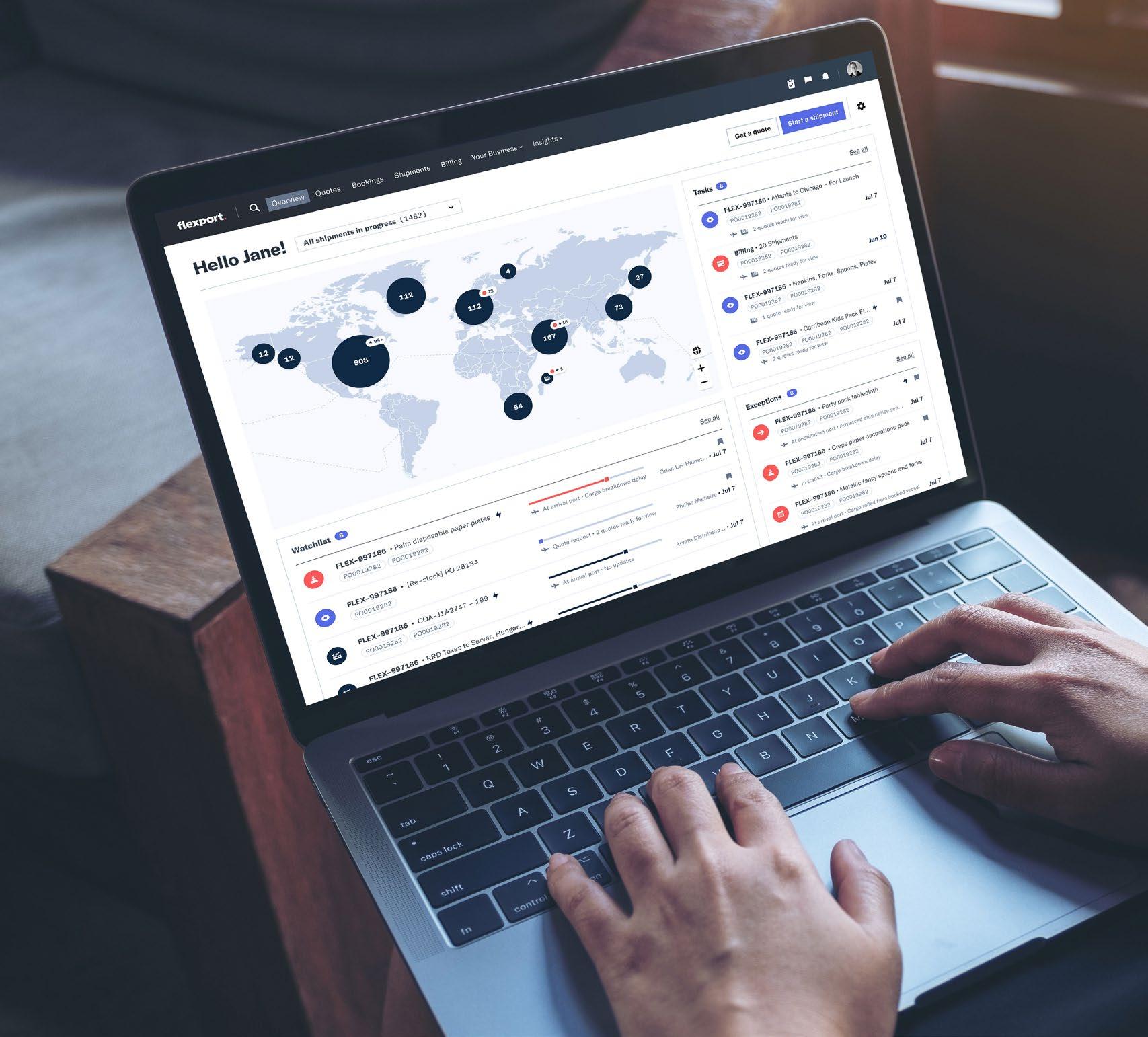
4 minute read
Reworking The Methodology Of Better, More Efficient Delivery
BY: DAVID HODES
While the world settles back into a normal, pandemic-free mode, intermodal distribution, the sector that took one of the biggest economic hits, is trying to make up for lost ground. Getting back to pre-pandemic levels has proven to be challenging at best. But the necessary work is getting done.
Post-pandemic, intermodal companies are focusing more now on agility, sustainability, and resilience in their operations. They have to come to terms with the new e-commerce demands that the consumer wants—that the consumer demands—as a result of the disruption from the pandemic.
The Flexport Platform’s multi modal booking system brings it all together. full container load, less than container load, air, trucking, and rail. A unified view helps everyone balance speed, cost, and compliance. Courtesy Flexport
The Amazon Model
As always, Amazon leads the way among intermodal companies and new ideas for more operational efficiency.
In July, Amazon began soliciting business from shippers interested in using the space in the company’s fleet of 53-foot intermodal containers. That puts Amazon in direct competition with intermodal providers such as Hub Group and others. Hub Group offers access to marine container space through their Marine Container Solutions program.
Amazon bought its first 250 domestic containers in 2019 and has since expanded the fleet to more than 5,000 boxes, according to RailFreight.com. The move is in line with Amazon’s ongoing strategy to become a fully-fledged third-party logistics services provider to control more aspects of the supply chain.
Amazon has moved to create its own airline as well, operating its own airport hubs, procuring a non-vessel operating common carrier license for ocean transport and a fleet of thousands of truck trailers.
From 2020 to 2022, Amazon added more aircraft to their air cargo fleet, which they started in 2016 (they have more than 110 in their global network today).
The company is in the process now of converting ten A330s from passenger to cargo carriers, which will be the first A330 freighter conversions to operate in the U.S. The A330s are leased through Altavair, a global aviation leasing and finance company, and are operated by Hawaiian Airlines. They are expected to begin flight operations in late 2023, according to Sarah Rhoads, vice president, Amazon Global Air. “These A330s will not only be the first of their kind in our fleet, but they’ll also be the newest, largest aircraft for Amazon Air, allowing us to deliver more customer packages with each flight,” Roads wrote in a report on the company’s website.
Amazon has also launched new air cargo support facilities, including their U.S. air hub at the Cincinnati/Northern Kentucky International Airport in Hebron, Kentucky and their European air hub at Leipzig/Halle Airport in Germany. And they have leaned into sustainable initiatives such as electric ground service equipment and sustainable aviation fuel.
Other Intermodal Giants Making Moves
Another of the world’s big intermodal companies, Maersk, a global shipping company that has recently been demonstrating ship-to-ship drone delivery of supplies, announced a new intermodal freight service to start between the Far East to Europe called AE66.
They are now ready for shifting customer demands, using dynamic routing and scheduling tools. They have to have supply chain visibility and resilience, and invest in real-time tracking and monitoring of shipments, to survive and thrive.

It’s become a more complicated game of getting the customer what he or she wants when he or she wants them. But new ideas, and new methodologies, are being brought to bear that should help drive the goals and objectives of the industry, and begin the catch-up game in earnest.
The new sea-rail-sea service runs west-bound, departing from the seaport of Vostochniy in Russia Far East to Kaliningrad on the Baltic Sea, with the possibility of further expansion. Transit times of the new regular service are significantly reduced, Maersk notes in the announcement of the new freight service. It can transport goods in less than 20 days to Kaliningrad and the adjacent locations in the Baltics region, compared to an average of 55-60 days for ocean routes via the Suez Canal.
Uber Freight, a digital freight brokerage platform connecting shippers and carriers, noted that smaller carriers and owner-operators are exiting the market at a faster pace in part due to the ongoing economic effects of the pandemic. “January saw the largest net decline in carrier population ever recorded, as 93,000 carriers had their operating authorities revoked,” according to Uber Freight’s Monthly Economic Market Update.
There may still be sector-specific downturns, according to Uber’s market update, including a freight recession. A review of their aggregate truckload demand index shows that freight demand has been falling since the second quarter of 2022. In December, demand was flat year-over-year, and down about 4 percent from April 2022.
It’s not all doom and gloom in intermodal operations, though.
The market has also taken some pressure off shippers’ budgets, according to Uber’s monthly economic update, allowing them to invest in areas where they could not in the past two years. As a result, “sustainability is a clear winner,” the economic update noted.
In fact, Uber Freight moved its first load on a fully electric truck in January, after which several shippers expressed interest. “This will expand further as the technology matures, with cheaper and better batteries, and more access to chargers,” the update added. “Shippers who are adopting this technology early on are also learning quickly what it takes to support electric vehicle (EV) deployment, and how to become the shipper of choice to attract EV trucks.”
Flexport, a digital freight forwarder, made a strategic new-hire for the company in January: Teresa Carlson, a former Microsoft Corp. and Amazon.com Inc. executive. She will reportedly help drive the company’s expansion into global markets.

An article about the Carlson’s hiring at Flexport reported that the company is “trying to capitalize on the shift to digitization in logistics that the pandemic has accelerated.” Flexport announced a funding round of $935 million last February, bringing its valuation to more than $8 billion.
Flexport plans to double the size of its engineering team this year by hiring 350 to 400 software programmers.
The Future
What’s becoming clear recently is that the best way to increase efficiencies in intermodal operations is by collaborations and partnerships between multiple stakeholders that often involves using various platforms, artificial intelligence, and the cloud.

Here are a few examples:
• In 2017, Norfolk Southern (NS) announced a new joint interline service initiative to reduce transit times by one to two days for carload traffic between western Canada and NS destinations in the eastern United States. This allows freight to bypass traditional interchange points in Chicago, in favor of using the most efficient existing Canadian Railway (CN) and NS routes. The service has reduced transit times by up to 48 hours, providing customers more efficient delivery to final destinations.


• In December, 2021, CN announced that it would be working with Google Cloud in a seven-year partnership aimed at developing the application of CN’s digital scheduled










